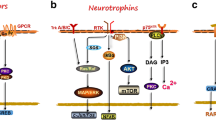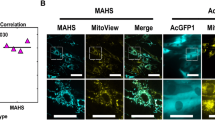Abstract
Human amniotic membrane (hAM) is a tissue containing cells with proven stem cell properties. In its decellularized form it has been successfully applied as nerve conduit biomaterial to improve peripheral nerve regeneration in injury models. We hypothesize that viable hAM without prior cell isolation can be differentiated towards the Schwann cell lineage to generate a possible alternative to commonly applied tissue engineering materials for nerve regeneration. For in vitro Schwann cell differentiation, biopsies of hAM of 8 mm diameter were incubated with a sequential order of neuronal induction and growth factors for 21 days and characterized for cellular viability and the typical glial markers glial fibrillary acidic protein (GFAP), S100β, p75 and neurotrophic tyrosine kinase receptor (NTRK) using immunohistology. The secretion of the neurotrophic factors brain-derived neurotrophic factor (BDNF) and glial cell-derived neurotrophic factor (GDNF) was quantified by ELISA. The hAM maintained high viability, especially under differentiation conditions (90.2 % ± 41.6 day 14; 80.0 % ± 44.5 day 21 compared to day 0). Both, BDNF and GDNF secretion was up-regulated upon differentiation. The fresh membrane stained positive for GFAP and p75 and NTRK, which was strongly increased after culture in differentiation conditions. Especially the epithelial layer within the membrane exhibited a change in morphology upon differentiation forming a multi-layered epithelium with intense accumulations of the marker proteins. However, S100β was expressed at equal levels and equal distribution in fresh and cultured hAM conditions. Viable hAM may be a promising alternative to present formulations used for peripheral nerve regeneration.




Similar content being viewed by others
References
Adinolfi M, Akle CA, McColl I, Fensom AH, Tansley L, Connolly P, Hsi BL, Faulk WP, Travers P, Bodmer WF (1982) Expression of HLA antigens, beta 2-microglobulin and enzymes by human amniotic epithelial cells. Nature 295:325–327
Akle CA, Adinolfi M, Welsh KI, Leibowitz S, McColl I (1981) Immunogenicity of human amniotic epithelial cells after transplantation into volunteers. Lancet 2:1003–1005
Bailo M, Soncini M, Vertua E, Signoroni PB, Sanzone S, Lombardi G, Arienti D, Calamani F, Zatti D, Paul P, Albertini A, Zorzi F, Cavagnini A, Candotti F, Wengler GS, Parolini O (2004) Engraftment potential of human amnion and chorion cells derived from term placenta. Transplantation 78:1439–1448
Caddick J, Kingham PJ, Gardiner NJ, Wiberg M, Terenghi G (2006) Phenotypic and functional characteristics of mesenchymal stem cells differentiated along a Schwann cell lineage. Glia 54:840–849
Cargnoni A, Gibelli L, Tosini A, Signoroni PB, Nassuato C, Arienti D, Lombardi G, Albertini A, Wengler GS, Parolini O (2009) Transplantation of allogeneic and xenogeneic placenta-derived cells reduces bleomycin-induced lung fibrosis. Cell Transpl 18:405–422
Chernousov MA, Yu WM, Chen ZL, Carey DJ, Strickland S (2008) Regulation of Schwann cell function by the extracellular matrix. Glia 56:1498–1507
Davis GE, Blaker SN, Engvall E, Varon S, Manthorpe M, Gage FH (1987) Human amnion membrane serves as a substratum for growing axons in vitro and in vivo. Science 236:1106–1109
di Summa PG, Kalbermatten DF, Raffoul W, Terenghi G, Kingham PJ (2013) Extracellular matrix molecules enhance the neurotrophic effect of Schwann cell-like differentiated adipose-derived stem cells and increase cell survival under stress conditions. Tissue Eng Part A 19:368–379
Hennerbichler S, Reichl B, Pleiner D, Gabriel C, Eibl J, Redl H (2007) The influence of various storage conditions on cell viability in amniotic membrane. Cell Tissue Bank 8:1–8
Hubert T, Grimal S, Carroll P, Fichard-Carroll A (2009) Collagens in the developing and diseased nervous system. Cell Mol Life Sci 66:1223–1238
Insausti CL, Blanquer M, Bleda P, Iniesta P, Majado MJ, Castellanos G, Moraleda JM (2010) The amniotic membrane as a source of stem cells. Histol Histopathol 25:91–98
Jiang L, Zhu JK, Liu XL, Xiang P, Hu J, Yu WH (2008) Differentiation of rat adipose tissue-derived stem cells into Schwann-like cells in vitro. Neuroreport 19:1015–1019
Kakishita K, Nakao N, Sakuragawa N, Itakura T (2003) Implantation of human amniotic epithelial cells prevents the degeneration of nigral dopamine neurons in rats with 6-hydroxydopamine lesions. Brain Res 980:48–56
Keilhoff G, Goihl A, Stang F, Wolf G, Fansa H (2006a) Peripheral nerve tissue engineering: autologous Schwann cells versus transdifferentiated mesenchymal stem cells. Tissue Eng 12:1451–1465
Keilhoff G, Stang F, Goihl A, Wolf G, Fansa H (2006b) Transdifferentiated mesenchymal stem cells as alternative therapy in supporting nerve regeneration and myelination. Cell Mol Neurobiol 26:1235–1252
Kingham PJ, Kalbermatten DF, Mahay D, Armstrong SJ, Wiberg M, Terenghi G (2007) Adipose-derived stem cells differentiate into a Schwann cell phenotype and promote neurite outgrowth in vitro. Exp Neurol 207:267–274
Kronsteiner B, Peterbauer-Scherb A, Grillari-Voglauer R, Redl H, Gabriel C, van Griensven M, Wolbank S (2011a) Human mesenchymal stem cells and renal tubular epithelial cells differentially influence monocyte-derived dendritic cell differentiation and maturation. Cell Immunol 267:30–38
Kronsteiner B, Wolbank S, Peterbauer A, Hackl C, Redl H, van Griensven M, Gabriel C (2011b) Human mesenchymal stem cells from adipose tissue and amnion influence T-cells depending on stimulation method and presence of other immune cells. Stem Cells Dev 20:2115–2126
Liang HS, Liang P, Xu Y, Wu JN, Liang T, Xu XP, Liu EZ (2009) Denuded human amniotic membrane seeding bone marrow stromal cells as an effective composite matrix stimulates axonal outgrowth of rat neural cortical cells in vitro. Acta Neurochir (Wien) 151:1113–1120
Liang H, Li C, Gao A, Liang P, Shao Y, Lin T, Zhang X (2012) Spinal duraplasty with two novel substitutes restored locomotor function after acute laceration spinal cord injury in rats. J Biomed Mater Res B Appl Biomater 100:2131–2140
Lindenmair A, Wolbank S, Stadler G, Meinl A, Peterbauer-Scherb A, Eibl J, Polin H, Gabriel C, van Griensven M, Redl H (2010) Osteogenic differentiation of intact human amniotic membrane. Biomaterials 31:8659–8665
Mahay D, Terenghi G, Shawcross SG (2008) Schwann cell mediated trophic effects by differentiated mesenchymal stem cells. Exp Cell Res 314:2692–2701
Mahmoudi-Rad M, Abolhasani E, Moravvej H, Mahmoudi-Rad N, Mirdamadi Y (2013) Acellular amniotic membrane: an appropriate scaffold for fibroblast proliferation. Clin Exp Dermatol 38:646–651
Manuelpillai U, Lourensz D, Vaghjiani V, Tchongue J, Lacey D, Tee JY, Murthi P, Chan J, Hodge A, Sievert W (2012) Human amniotic epithelial cell transplantation induces markers of alternative macrophage activation and reduces established hepatic fibrosis. PLoS ONE 7:e38631
Miki T, Strom SC (2006) Amnion-derived pluripotent/multipotent stem cells. St Cell Rev 2:133–142
Mligiliche N, Endo K, Okamoto K, Fujimoto E, Ide C (2002) Extracellular matrix of human amnion manufactured into tubes as conduits for peripheral nerve regeneration. J Biomed Mater Res 63:591–600
Ndubaku U, de Bellard ME (2008) Glial cells: old cells with new twists. Acta Histochem 110:182–195
Park HW, Lim MJ, Jung H, Lee SP, Paik KS, Chang MS (2010) Human mesenchymal stem cell-derived Schwann cell-like cells exhibit neurotrophic effects, via distinct growth factor production, in a model of spinal cord injury. Glia 58:1118–1132
Parolini O, Alviano F, Bergwerf I, Boraschi D, De BC, De WP, Dominici M, Evangelista M, Falk W, Hennerbichler S, Hess DC, Lanzoni G, Liu B, Marongiu F, McGuckin C, Mohr S, Nolli ML, Ofir R, Ponsaerts P, Romagnoli L, Solomon A, Soncini M, Strom S, Surbek D, Venkatachalam S, Wolbank S, Zeisberger S, Zeitlin A, Zisch A, Borlongan CV (2010) Toward cell therapy using placenta-derived cells: disease mechanisms, cell biology, preclinical studies, and regulatory aspects at the round table. St Cells Dev 19:143–154
Peterbauer-Scherb A, Danzer M, Gabriel C, van Griensven M, Redl H, Wolbank S (2012) In vitro adipogenesis of adipose-derived stem cells in 3D fibrin matrix of low component concentration. J Tissue Eng Regen Med 6:434–442
Pratama G, Vaghjiani V, Tee JY, Liu YH, Chan J, Tan C, Murthi P, Gargett C, Manuelpillai U (2011) Changes in culture expanded human amniotic epithelial cells: implications for potential therapeutic applications. PLoS ONE 6:e26136
Riau AK, Beuerman RW, Lim LS, Mehta JS (2010) Preservation, sterilization and de-epithelialization of human amniotic membrane for use in ocular surface reconstruction. Biomaterials 31:216–225
Ricci E, Vanosi G, Lindenmair A, Hennerbichler S, Peterbauer-Scherb A, Wolbank S, Cargnoni A, Signoroni PB, Campagnol M, Gabriel C, Redl H, Parolini O (2012) Anti-fibrotic effects of fresh and cryopreserved human amniotic membrane in a rat liver fibrosis model. Cell Tissue Bank
Sakuragawa N, Kakinuma K, Kikuchi A, Okano H, Uchida S, Kamo I, Kobayashi M, Yokoyama Y (2004) Human amnion mesenchyme cells express phenotypes of neuroglial progenitor cells. J Neurosci Res 78:208–214
Stadler G, Hennerbichler S, Lindenmair A, Peterbauer A, Hofer K, van Griensven M, Gabriel C, Redl H, Wolbank S (2008) Phenotypic shift of human amniotic epithelial cells in culture is associated with reduced osteogenic differentiation in vitro. Cytotherapy 10:743–752
Takashima S, Yasuo M, Sanzen N, Sekiguchi K, Okabe M, Yoshida T, Toda A, Nikaido T (2008) Characterization of laminin isoforms in human amnion. Tissue Cell 40:75–81
Terenghi G (1999) Peripheral nerve regeneration and neurotrophic factors. J Anat 194(Pt 1):1–14
Tohill M, Mantovani C, Wiberg M, Terenghi G (2004) Rat bone marrow mesenchymal stem cells express glial markers and stimulate nerve regeneration. Neurosci Lett 362:200–203
Tomita K, Madura T, Sakai Y, Yano K, Terenghi G, Hosokawa K (2013) Glial differentiation of human adipose-derived stem cells: implications for cell-based transplantation therapy. Neuroscience 236:55–65
Uchida S, Inanaga Y, Kobayashi M, Hurukawa S, Araie M, Sakuragawa N (2000) Neurotrophic function of conditioned medium from human amniotic epithelial cells. J Neurosci Res 62:585–590
Uziyel Y, Hall S, Cohen J (2000) Influence of laminin-2 on Schwann cell-axon interactions. Glia 32:109–121
Wallquist W, Plantman S, Thams S, Thyboll J, Kortesmaa J, Lannergren J, Domogatskaya A, Ogren SO, Risling M, Hammarberg H, Tryggvason K, Cullheim S (2005) Impeded interaction between Schwann cells and axons in the absence of laminin alpha4. J Neurosci 25:3692–3700
Wang J, Ding F, Gu Y, Liu J, Gu X (2009) Bone marrow mesenchymal stem cells promote cell proliferation and neurotrophic function of Schwann cells in vitro and in vivo. Brain Res 1262:7–15
Whittle WL, Gibb W, Challis JR (2000) The characterization of human amnion epithelial and mesenchymal cells: the cellular expression, activity and glucocorticoid regulation of prostaglandin output. Placenta 21:394–401
Wilshaw SP, Kearney J, Fisher J, Ingham E (2008) Biocompatibility and potential of acellular human amniotic membrane to support the attachment and proliferation of allogeneic cells. Tissue Eng Part A 14:463–472
Wolbank S, Hildner F, Redl H, van Griensven M, Gabriel C, Hennerbichler S (2009) Impact of human amniotic membrane preparation on release of angiogenic factors. J Tissue Eng Regen Med 3:651–654
Xu Y, Liu L, Li Y, Zhou C, Xiong F, Liu Z, Gu R, Hou X, Zhang C (2008) Myelin-forming ability of Schwann cell-like cells induced from rat adipose-derived stem cells in vitro. Brain Res 1239:49–55
Xue H, Zhang XY, Liu JM, Song Y, Li YF, Chen D (2013) Development of a chemically extracted acellular muscle scaffold seeded with amniotic epithelial cells to promote spinal cord repair. J Biomed Mater Res A 101:145–156
Yan ZJ, Zhang P, Hu YQ, Zhang HT, Hong SQ, Zhou HL, Zhang MY, Xu RX (2013) Neural stem-like cells derived from human amnion tissue are effective in treating traumatic brain injury in rat. Neurochem Res 38:1022–1033
Yang S, Xue DD, Wu B, Sun HM, Li XS, Dong F, Li WS, Ji FQ, Zhou DS (2013) Pleiotrophin is involved in the amniotic epithelial cell-induced differentiation of human umbilical cord blood-derived mesenchymal stem cells into dopaminergic neuron-like cells. Neurosci Lett 539:86–91
Acknowledgments
We would like to thank Daniela Dopler, Alice Zimmermann and Sidrah Chaudry for their technical assistance and Eva Schwingenschlögl for support with graphic design.
Conflict of interest
We would like to disclose that the co-authors Johann Eibl and Heinz Redl own the patent rights for “Process for differentiating stem cells of the amniotic membrane”.
Author information
Authors and Affiliations
Corresponding author
Rights and permissions
About this article
Cite this article
Banerjee, A., Nürnberger, S., Hennerbichler, S. et al. In toto differentiation of human amniotic membrane towards the Schwann cell lineage. Cell Tissue Bank 15, 227–239 (2014). https://doi.org/10.1007/s10561-013-9401-1
Received:
Accepted:
Published:
Issue Date:
DOI: https://doi.org/10.1007/s10561-013-9401-1




